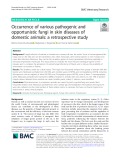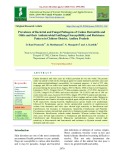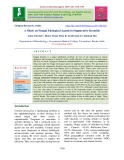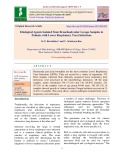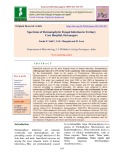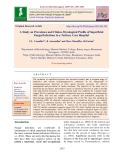
Fungal etiological agents
-
Fungal infections of animals or humans are common all over the world. Some of microorganisms like fungi, exist on the skin and can be transmitted onto other individuals, other animal species or even humans and cause skin infections. Moreover, they can be the causative agents of severe generalized infections especially in immunocompromised individuals.
 8p
8p  vigandhi
vigandhi
 23-02-2022
23-02-2022
 12
12
 1
1
 Download
Download
-
The present study help in identifying the etiological agents of canine dermatitis and otitis and in vitro antimicrobial and antifungal sensitivity tests against the known etiological agents and help in taking quick decision in selecting antimicrobials for effective treatment of canine dermatitis and otitis cases.
 15p
15p  caygaocaolon11
caygaocaolon11
 21-04-2021
21-04-2021
 8
8
 1
1
 Download
Download
-
Fungal keratitis is a major ophthalmic problem. In view of the importance in timely diagnosis and treatment of keratitis which would otherwise lead to serious complications like loss of vision, hypopyon formation, endopthalamitis, etc., this study was intended to bring into light the fungal etiological agents in suppurative keratitis. The specimen was collected from suppurative keratitis cases irrespective of prior antibiotic treatment during the period of one year from March 2012 to February 2013.
 10p
10p  trinhthamhodang1215
trinhthamhodang1215
 23-09-2020
23-09-2020
 9
9
 1
1
 Download
Download
-
Keratitis is the inflammation of the cornea. Fungi are the most common etiological agents which account for 30–40% of the cases whereas bacteria account for 13–48% of all cases of suppurative keratitis; this varies by geographical area1 . Fungal keratitis is an inflammation of the cornea caused by fungi. It is worldwide in distribution, but is more common in the tropics and subtropical regions. Fungal keratitis is an important cause of ocular morbidity and blindness worldwide and is a growing threat that has substantial morbidity and cost.
 10p
10p  kethamoi4
kethamoi4
 18-04-2020
18-04-2020
 13
13
 0
0
 Download
Download
-
Pneumonia and acute bronchitis are the most common Lower Respiratory Tract Infections (LRTIs). They are caused by a variety of organisms. 472 BAL samples collected from clinically suspected lower respiratory tract infections were processed in the microbiology laboratory. Of the total samples, males constituted 336 (71.2%) and 136 (28.8%) females. 223 (47.2%) of the samples were of age group 40-60 years. 383 (81.1%) of samples showed growth of various bacteria. Fungal isolation was seen in 21 (4.4%) of samples. This study shows various pathogens isolated from lower respiratory tract infections.
 5p
5p  cothumenhmong3
cothumenhmong3
 22-02-2020
22-02-2020
 22
22
 1
1
 Download
Download
-
Superficial mycoses are the most frequent forms of human infections, Dermatophytes affecting more than 20 to 25% of the world’s population. They are predominantly caused by the keratinophilic fungi in the genera of Trichophyton, Microsporum and Epidermophyton. 1. Isolation and identification of Dermatophytes causing skin, hair and nail infections. 2. To know the prevalence of Dermatophytic infections in Tertiary care hospital. This study was conducted from April 2018 to July 2018 in Department of Microbiology, J. J. M. Medical College, Davanagere.
 7p
7p  kequaidan2
kequaidan2
 11-12-2019
11-12-2019
 11
11
 0
0
 Download
Download
-
The incidence of superficial mycoses has increased recently due to frequent usage of antibiotics and various immunosuppressive conditions. In the background of immunosuppression, detection of these agents becomes necessary for effective management and prevention of further invasions. The objective of the study was to determine the prevalence and causative agents of superficial mycoses in order to provide early and efficient treatment. A cross-sectional study was conducted for 3 months (JuneAugust 2015) on patients with suspected superficial mycoses attending our Dermatology OPD.
 11p
11p  nguaconbaynhay1
nguaconbaynhay1
 04-12-2019
04-12-2019
 10
10
 0
0
 Download
Download
-
Candida species is the only fungal pathogen that causes variety of afflictions that ranges from superficial mucosal infections to life-threatening disseminated mycoses. Oral candidiasis is a common fungal infection caused by an overgrowth or infection due to Candida spp. Candida albicans is considered as the primary etiology of various clinical types of candidiasis including oral lesions. However, in recent years research studies have highlighted the greater recognition of non-albicans Candida (NAC) spp.
 6p
6p  nguaconbaynhay1
nguaconbaynhay1
 04-12-2019
04-12-2019
 17
17
 1
1
 Download
Download
CHỦ ĐỀ BẠN MUỐN TÌM








